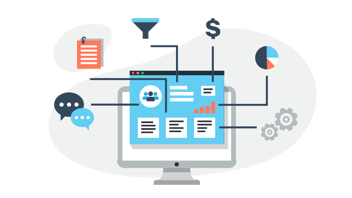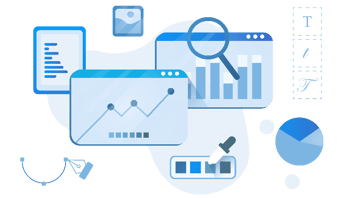The History of Conversion Rate Optimization and Why It's Here to Stay
The internet has revolutionized the way we shop. Gone are the days of physical browsing; today, with a few clicks, we can purchase anything imaginable. But for businesses, this digital landscape presents a unique challenge: converting website visitors into paying customers.
This begs the question: how did CRO come to be? This blog will dive through time, exploring the fascinating history of CRO. We'll delve into the early days of A/B testing, the rise of user experience (UX) as a key factor, and the exciting advancements shaping CRO in the modern age.

The story of conversion rate optimization (CRO) is intricately linked to the evolution of e-commerce. In the early days, websites were static, and conversion strategies relied heavily on intuition. Fast-forward to today, CRO has become a sophisticated science armed with data and fueled by cutting-edge technology.
Understanding CRO's history reveals a fundamental truth: CRO is not a passing fad. It's a practice with deep roots, constantly evolving to meet the ever-changing needs of online businesses and customers. By exploring its history, we gain valuable insights and pave the way for even more effective conversion strategies in the future.
The Early Days of CRO: 1990s
Imagine a time before social media and online shopping giants. The late 1990s witnessed the internet's explosion and, with it, the birth of e-commerce. Businesses scrambled to establish a digital presence, eager to tap into this vast new market.
In this Wild West era of online commerce, conversion strategies were a far cry from the sophisticated methods we know today. Early websites were often static and text-heavy, relying heavily on traditional marketing tactics borrowed from the offline world. Flashy banner ads and intrusive pop-ups dominated web pages, bombarding visitors with a relentless sales pitch. While these methods did generate some leads, their effectiveness was questionable, often leading to user frustration and a poor overall experience.
A turning point arrived with the emergence of A/B testing. This revolutionary concept, essentially showing different versions of a webpage to random visitors and measuring which one performs better, marked the dawn of scientific website optimization. It was a simple yet powerful idea: test variations, gather data, and iterate based on results.
One of the earliest A/B testing success stories involved a simple button color change. A company discovered that switching their "Buy Now" button from green to red resulted in a significant increase in clicks. This example perfectly illustrates the power of A/B testing. By making small, data-driven tweaks, businesses could begin to understand what resonated with their audience and optimize their websites for conversions.
While the early days of CRO were characterized by experimentation and a shift towards data-driven decision-making, the foundation for a powerful digital marketing practice had been laid.
The Evolution of CRO: 2000s
The early days of A/B testing laid the groundwork for CRO's evolution. But understanding what worked wasn't enough. Businesses needed to delve deeper into user behavior to truly optimize their websites.
Enter the dawn of web analytics. Tools like Google Analytics, launched in 2005, revolutionized CRO by providing a treasure trove of user data. Businesses could now track website traffic, identify popular pages, and analyze user journeys in detail. This newfound data allowed for a crucial shift: moving from intuition-based tactics to data-driven strategies.
Armed with insights into user behavior, CRO professionals could now identify areas of improvement and prioritize optimization efforts. Metrics like bounce rate (percentage of visitors who leave after one page) and time spent on the page became valuable indicators of user engagement.
However, data alone wasn't the whole picture. To truly understand user needs and frustrations, a new approach emerged: user testing. Involving real users interacting with your website while researchers observe and record their behavior, user testing provides invaluable qualitative data. Imagine watching a user struggle to navigate your complex checkout process – a clear sign that simplification is needed!
One impactful example of user testing involved a company struggling with low sign-up rates for their newsletter. User testing revealed a confusing registration form with unnecessary fields. By streamlining the form and focusing on essential information, the company witnessed a significant jump in sign-ups. This demonstrates how user testing can expose critical pain points for users, allowing for targeted improvements that directly impact conversions.
In parallel to user testing, the importance of content optimization became increasingly recognized. Search Engine Optimization (SEO) strategies gained traction, ensuring websites ranked higher in search engine results pages (SERPs), attracting more qualified traffic. Additionally, high-quality, engaging content emerged as a powerful tool for nurturing leads and building trust with potential customers. By creating informative blog posts, product descriptions, and compelling calls to action, businesses could guide users through the conversion funnel more effectively.
This era of CRO marked a significant shift from flashy ads to a focus on data, user experience, and valuable content. Businesses began to understand that true optimization lay in creating a website that catered to the needs and expectations of their target audience.
CRO in the Modern Age: Today and Tomorrow
The evolution of CRO didn't stop with data-driven optimization and user-centric design. The modern age of CRO is characterized by a relentless pursuit of personalization and the integration of cutting-edge technologies.
Personalization has become a game-changer, allowing businesses to tailor website experiences to individual users. Imagine a visitor browsing an online clothing store. Gone are the days of generic product displays. Today, websites can leverage visitor data like browsing history and past purchases to recommend relevant clothing items. This level of personalization creates a more engaging experience for users, increasing the likelihood of them finding products they'll love, ultimately leading to higher conversions.
For example, an online retailer might use dynamic content to showcase product recommendations based on a user's recent searches. If a visitor has been browsing for hiking boots, the website might display a personalized banner featuring top-rated hiking boots alongside complementary items like socks or backpacks. This targeted approach significantly boosts conversion rates compared to generic product displays.
But personalization is just the tip of the iceberg. The rise of Artificial Intelligence (AI) and machine learning is transforming CRO in ways unimaginable a decade ago. AI algorithms can analyze vast amounts of user data, identifying patterns and predicting user behavior with incredible accuracy. This allows for automation of tasks like A/B testing and personalization, freeing up human resources for more strategic endeavors.
Furthermore, AI can power highly effective predictive analytics. Imagine a website that can anticipate a user's needs even before they articulate them. AI can analyze user behavior in real time and trigger targeted interventions, such as offering a discount code at the exact moment a user hesitates to abandon their cart. This level of predictive power allows businesses to optimize the conversion funnel with laser-like precision.
One example of AI in action could be a travel website that uses machine learning to personalize flight and hotel recommendations based on a user's past travel preferences and budget. This personalized approach not only increases conversion rates but also fosters customer satisfaction by presenting highly relevant travel options.
Looking towards the future, CRO is poised to embrace even more innovative technologies. Voice search optimization will become crucial as users increasingly interact with websites through voice commands. Additionally, augmented reality (AR) could revolutionize product visualization, allowing potential customers to virtually "try on" clothes or experience furniture placement in their homes before purchase. These cutting-edge advancements will undoubtedly shape the future of CRO, further blurring the lines between the physical and digital worlds.
Why CRO is Here to Stay
If you're still wondering why CRO isn't just a fad, consider the numbers:
-
A 1% increase in conversion rate can translate to a substantial revenue boost for businesses, and a 9.7% conversion rate increase led to a 132% increase in revenue for a SaaS company.
-
Businesses that use conversion rate optimization tools typically see a 223% average return on investment (ROI).
-
Data indicates that as of July 2024, mobile browsing accounts for 59.6% of global web traffic, emphasizing the crucial role of mobile-first CRO strategies.
-
A well-designed user experience (UX) can lead to a 200% increase in customer satisfaction and a 13% increase in revenue.
Today's online customer journey is far more complex than ever before. With countless options available at their fingertips, consumers are increasingly selective. A poorly optimized website can easily frustrate potential customers, driving them to competitors with a smoother user experience. CRO empowers businesses to stay competitive by crafting websites that guide users seamlessly through the conversion funnel.
Furthermore, the rise of mobile browsing has fundamentally changed the way we interact with the internet. Statistics show that a significant portion of online traffic now originates from mobile devices. Mobile-first CRO strategies are no longer optional; they're essential for capturing the attention of mobile users and converting them into loyal customers. Imagine a website that looks great on a desktop computer but becomes clunky and unusable on a smartphone – a surefire way to lose potential customers.
The key to successful CRO lies in embracing a continuous improvement mindset. The online landscape is constantly evolving, and user expectations are ever-changing. Therefore, CRO isn't a one-time fix; it's an ongoing process that requires continuous testing, iteration, and adaptation. By routinely evaluating website performance, identifying areas for improvement, and implementing data-driven changes, businesses can ensure their CRO efforts remain relevant and effective.
In short, CRO isn't just about increasing conversions today; it's about creating a website that can adapt and thrive in the ever-changing digital world. By prioritizing user experience, leveraging data and technology, and adopting a continuous improvement approach, businesses can unlock the true power of CRO and secure their long-term success in the competitive online marketplace.
The Future is CRO: A Call to Conversion Optimization
This blog highlights a crucial truth: conversion rate optimization isn't a fad; it's a foundational digital marketing practice with deep roots. By understanding its historical development, we gain valuable insights for crafting even more effective CRO strategies in the future.
The numbers speak for themselves: CRO holds the power to significantly boost conversions, enhance user experience, and ultimately drive business growth. In today's competitive online landscape, a well-optimized website is no longer a luxury; it's a necessity.
At Aspiration Marketing, we're passionate about CRO. Our team of experts can guide you through the entire process, from identifying optimization opportunities to implementing data-driven strategies and measuring results. Let us help you create a website that converts visitors into loyal customers and drives your business toward long-term success.
Are you ready to unlock the true potential of your website?
This content is also available in:
- Deutsch: Die Geschichte der Conversion-Rate-Optimierung. Ist sie wichtig?
- Español: Historia de la optimización de tasa de conversión y su permanencia
- Français: L'histoire de l'optimisation des taux de conversion et son importance
- Italiano: Storia dell'ottimizzazione conversioni e perché è qui per restare
- Română: Istoria optimizării ratei de conversie și de ce va persista
- 简体中文: 转化率优化的历史及其长盛不衰的原因









Leave a Comment